Although the Microsoft 70-458 dumps are very popular, GreatExam offers a wide range of Microsoft 70-458 exam dumps and will continue to release new study guide to meet the rapidly increasing demand of the IT industry.
QUESTION 81
Drag and Drop Question
You administer a database named SalesDb that has users named UserA, userB, and UserC.
You need to ensure that the following requirements are met:
– UserA must be able to provide Windows logins access to the database.
– UserB must be able to select, update, delete, and insert data to the database tables.
– UserC must be able to create new tables and stored procedures.
You need to achieve this goal by granting only the minimum permissions required.
To which fixed database role or roles should you add the users? (To answer, drag the appropriate use role or roles. Answer choices may be used once, more than once, or not at all. Answer targets may be additionally, you may need to drag the split bar between panes or scroll to view content.)
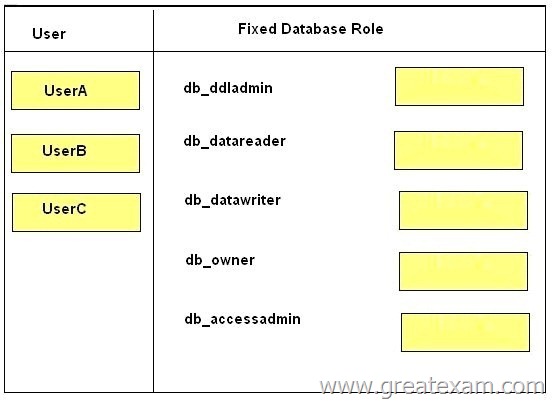
Answer:
Box 1:
db_ddladmin: UserC
UserC needs to be able to add tables and procedures. He can do these through the db_ddladmin role (through the create statement).
Members of the db_ddladmin fixed database role can run any Data Definition Language (DDL) command in a database.
DDL is abbreviation of Data Definition Language. It is used to create and modify the structure of database objects in database.
Examples: CREATE, ALTER, DROP statements
Box 2:
db_datareader: UserB
UserB needs to be able to select data.
Members of the db_datareader fixed database role can run a SELECT statement against any table or view in the database.
Box 3:
db_datawriter: UserB
UserB needs to update, delete, and insert data. He can do these through the db_datawriter role. Members of the db_datawriter fixed database role can add, delete, or change data in all user tables.
Box 4:
db_owner: <leave blank>
Not required in this scenario.
Members of the db_owner fixed database role can perform all configuration and maintenance activities on the database.
Box 5:
db_acccessadmin: UserA
This enables UserA to provide Windows logins access. Members of the db_accessadmin fixed database role can add or remove access for Windows logins, Windows groups, and SQL Server logins.
QUESTION 82
Drag and Drop Question
You administer several Microsoft SQL Server 2012 servers.
Your company has a number of offices across the world connected by using a wide area network (WAN).
Connections between offices vary significantly in both bandwidth and reliability.
You need to identify the correct replication method for each scenario.
What should you do? (To answer, drag the appropriate replication method or methods to the correct location or locations in the answer area. Each replication method may be used once, more than once, or not at all.)
Answer: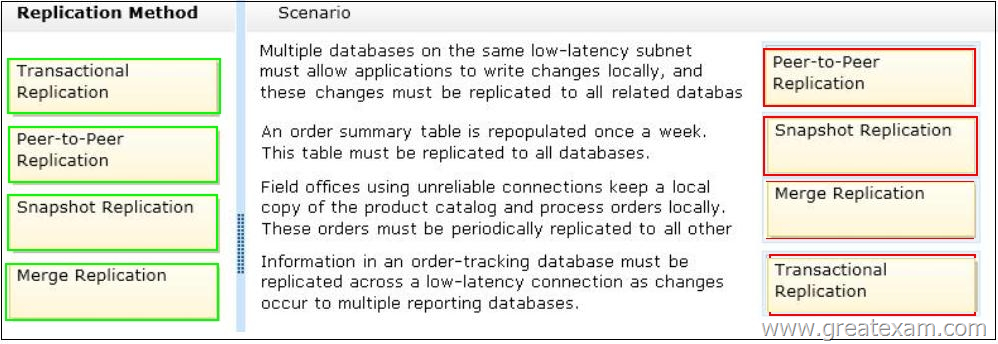
Explanation:
http://msdn.microsoft.com/en-us/library/ms151198.aspx
QUESTION 83
Drag and Drop Question
You are a database administrator of a Microsoft SQL Server 2012 environment.
The environment contains two servers named SQLServer01 and SQLServer02.
The database Contoso exists on SQLServer01.
You plan to mirror the Contoso database between SQLServer01 and SQLServer02 by using database mirroring.
You need to prepare the Contoso database for database mirroring.
Which three actions should you perform in sequence? (To answer, move the appropriate actions from the list of actions to the answer area and arrange them in the correct order.)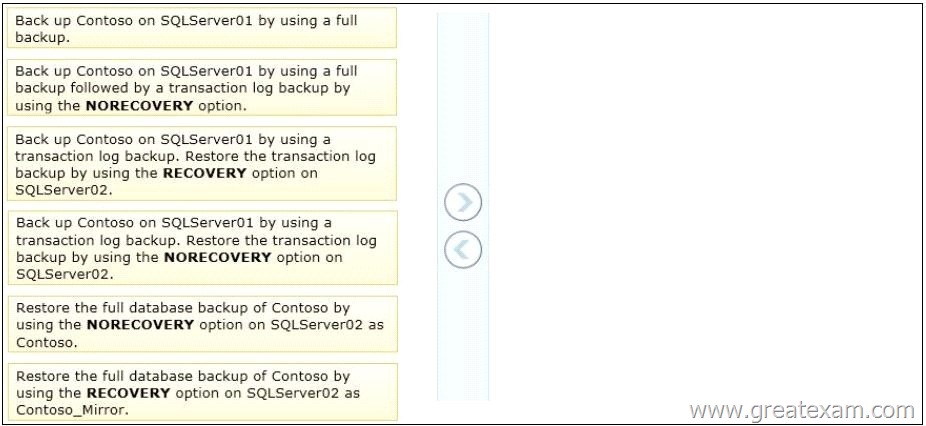
Answer: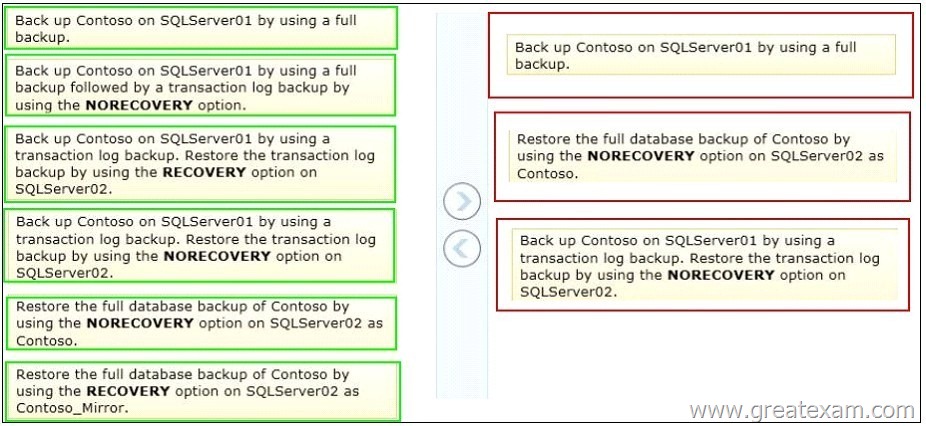
Explanation:
http://msdn.microsoft.com/en-us/library/ms190941.aspx
http://msdn.microsoft.com/en-us/library/ms189852.aspx
QUESTION 84
You create an availability group that has replicas named HA/Server01 and HA/Server02. Currently, HA/Server01 is the primary replica.
You have multiple queries that read data and produce reports from the database.
You need to offload the reporting workload to the secondary replica when HA/Server01 is the primary replica.
What should you do?
A. Set the Availability Mode property of HA/Server02 to Asynchronous commit.
B. Set the Readable Secondary property of HA/Server02 to Read-intent only.
C. Set the Connections in Primary Role property of HA/Server01 to Allow read/write connections.
D. Set the Availability Mode property of HA/Server01 to Asynchronous commit.
Answer: B
Explanation:
http://msdn.microsoft.com/en-us/library/jj542414.aspx
QUESTION 85
You administer several Microsoft SQL Server 2012 database servers.
Merge replication has been configured for an application that is distributed across offices throughout a wide area network (WAN).
Many of the tables involved in replication use the XML and varchar (max) data types. Occasionally, merge replication fails due to timeout errors.
You need to reduce the occurrence of these timeout errors.
What should you do?
A. Set the Merge agent on the problem subscribers to use the slow link agent profile.
B. Create a snapshot publication, and reconfigure the problem subscribers to use the snapshot publication.
C. Change the Merge agent on the problem subscribers to run continuously.
D. Set the Remote Connection Timeout on the Publisher to 0.
Answer: A
Explanation:
http://msdn.microsoft.com/en-us/library/ms151223.aspx http://msdn.microsoft.com/en-us/library/ms147839.aspx
QUESTION 86
You administer a Microsoft SQL Server 2012 database.
You create an availability group named haContosoDbs.
Your primary replica is available at Server01\Contoso01.
You need to configure the availability group to have the highest availability.
You also need to ensure that no data is lost.
Which Transact-SQL statement should you use?
A. ALTER AVAILABILITY GROUP haContosoDbs MODIFY REPLICA ON ‘Server01\Contoso01’ WITH
(AVAILABILITY_MODE = ASYNCHRONOUS_COMMIT, FAILOVER_MODE = AUTOMATIC)
B. ALTER AVAILABILITY GROUP haContosoDbs MODIFY REPLICA ON ‘Server01\Contoso01’ WITH
(AVAILABILITY_MODE = SYNCHRONOUS_COMMIT, FAILOVER_MODE = MANUAL)
C. ALTER AVAILABILITY GROUP haContosoDbs MODIFY REPLICA ON ‘Server01\Contoso01’ WITH
(AVAILABILITY_MODE = SYNCHRONOUS_COMMIT, FAILOVER_MODE = AUTOMATIC)
D. ALTER AVAILABILITY GROUP haContosoDbs MODIFY REPLICA ON ‘Server01\Contoso01’ WITH
(AVAILABILITY_MODE = ASYNCHRONOUS_COMMIT, FAILOVER_MODE = MANUAL)
Answer: C
Explanation:
http://msdn.microsoft.com/en-us/library/ff877931.aspx
QUESTION 87
You administer two Microsoft SQL Server 2012 servers.
Each server resides in a different, untrusted domain.
You plan to configure database mirroring.
You need to be able to create database mirroring endpoints on both servers.
What should you do?
A. Configure the SQL Server service account to use Network Service.
B. Use a server certificate.
C. Use a database certificate.
D. Configure the SQL Server service account to use Local System.
Answer: B
Explanation:
http://technet.microsoft.com/en-us/library/ms179511.aspx
http://technet.microsoft.com/en-us/library/ms186384.aspx
QUESTION 88
You are migrating a database named Orders to a new server that runs Microsoft SQL Server 2012.
You attempt to add the [Corpnet\User1] login to the database.
However, you receive the following error message:
“User already exists in current database.”
You need to configure the [Corpnet\User1] login to be able to access the Orders database and retain the original permissions.
You need to achieve this goal by using the minimum required permissions.
Which Transact-SQL statement should you use?
A. DROP USER [User1];
CREATE USER [Corpnet\User1] FOR LOGIN [Corpnet\User1];
ALTER ROLE [db_owner] ADD MEM3ER [Corpnet\User1];
B. ALTER SERVER RCLS Isysadmin] ADD MEMBER [Corpnet\User1];
C. ALTER USER [Corpnet\User1] WITH LOGIN [Corpnet\User1];
D. ALTER ROLE [db owner] ADD MEMBBR [Corpnet\User1];
Answer: C
Explanation:
http://msdn.microsoft.com/en-us/library/ms176060.aspx
QUESTION 89
You administer a Microsoft SQL Server 2012 database.
You configure Transparent Data Encryption (TDE) on the Orders database by using the following statements:
You attempt to restore the Orders database and the restore fails.
You copy the encryption file to the original location.
A hardware failure occurs and so a new server must be installed and configured. After installing SQL Server to the new server, you restore the Orders database and copy the encryption files to their original location. However, you are unable to access the database.
You need to be able to restore the database.
Which Transact-SQL statement should you use before attempting the restore?
A. CREATE ASSEMBLY TDE_Assembly FROM ‘d:\TDE_Certificate.cer’ WITH PERMISSION_SET = SAFE;
GO
CREATE CERTIFICATE TDE_Certificate FROM ASSEMBLY TDE_Assembly;
B. CREATE CERTIFICATE TDE_Certificate FROM EXECUTABLE FILE = ‘d:\TDE_Certificate.cer’
C. CREATE CERTIFICATE TDE_Certificate FROM FILE = ‘d:\TDE_Certificate.cer’ WITH PRIVATE KEY
(FILE = ‘d:\TDE_Certificate.key’,
DECRYPTION BY PASSWORD ‘MyPassword1!’);
D. DECLARE @startdate date
SET @startdate = GETDATE()
CREATE CERTIFICATE TDE_Certificate FROM FILE = ‘d:\TDE_Certificate.cer’ WITH START_DATE
= @startdate;
Answer: C
Explanation:
http://msdn.microsoft.com/en-us/library/ff773063.aspx
http://msdn.microsoft.com/en-us/library/bb510663.aspx
http://msdn.microsoft.com/en-us/library/bb934049.aspx
QUESTION 90
You administer a Microsoft SQL Server 2012 database that has Trustworthy set to On.
You create a stored procedure that returns database-level information from Dynamic Management Views.
You grant User1 access to execute the stored procedure.
You need to ensure that the stored procedure returns the required information when User1 executes the stored procedure.
You need to achieve this goal by granting the minimum permissions required.
What should you do? (Each correct answer presents a complete solution. Choose all that apply.)
A. Create a SQL Server login that has VIEW SERVER STATE permissions.
Create an application role and a secured password for the role.
B. Modify the stored procedure to include the EXECUTE AS OWNER statement.
Grant VIEW SERVER STATE permissions to the owner of the stored procedure.
C. Create a SQL Server login that has VIEW SERVER STATE permissions.
Modify the stored procedure to include the EXECUTE AS {newlogin} statement.
D. Grant the db_owner role on the database to User1.
E. Grant the sysadmin role on the database to User1.
Answer: BC
Explanation:
http://msdn.microsoft.com/en-us/library/ms187861.aspx
http://msdn.microsoft.com/en-us/library/ms191291.aspx
QUESTION 91
You use a contained database named ContosoDb within a domain.
You need to create a user who can log on to the ContosoDb database.
You also need to ensure that you can port the database to different database servers within the domain without additional user account configurations.
Which type of user should you create?
A. SQL user without login
B. SQL user with a custom SID
C. SQL user with login
D. Domain user
Answer: D
Explanation:
http://msdn.microsoft.com/en-us/library/ff929071.aspx
QUESTION 92
You are the lead database administrator (DBA) of a Microsoft SQL Server 2012 environment.
All DBAs are members of the DOMAIN\JrDBAs Active Directory group.
You grant DOMAIN\JrDBAs access to the SQL Server.
You need to create a server role named SpecialDBARole that can perform the following functions:
– View all databases.
– View the server state.
– Assign GRANT, DENY, and REVOKE permissions on logins.
You need to add DOMAIN\JrDBAs to the server role.
You also need to provide the least level of privileges necessary.
Which SQL statement or statements should you use? Choose all that apply.
A. CREATE SERVER ROLE [SpecialDBARole] AUTHORIZATION setupadmin;
B. ALTER SERVER ROLE [SpecialDBARole] ADD MEMBER [DOMAIN\JrDBAs];
C. CREATE SERVER ROLE [SpecialDBARole] AUTHORIZATION securityadmin;
D. GRANT VIEW DEFINITION TO [SpecialDBARole];
E. CREATE SERVER ROLE [SpecialDBARole] AUTHORIZATION serveradmin;
F. GRANT VIEW SERVER STATE, VIEW ANY DATABASE TO [SpecialDBARole];
Answer: BCF
Explanation:
http://msdn.microsoft.com/en-us/library/ee677634.aspx
http://msdn.microsoft.com/en-us/library/ms188659.aspx
http://msdn.microsoft.com/en-us/library/ms191291.aspx
QUESTION 93
You administer a Microsoft SQL Server 2012 server.
You plan to deploy new features to an application.
You need to evaluate existing and potential clustered and non-clustered indexes that will improve performance.
What should you do?
A. Query the sys.dm_db_index_usage_stats DMV.
B. Query the sys.dm_db_missing_index_details DMV.
C. Use the Database Engine Tuning Advisor.
D. Query the sys.dm_db_missing_index_columns DMV.
Answer: C
Explanation:
http://msdn.microsoft.com/en-us/library/ms174202.aspx
QUESTION 94
Drag and Drop Question
You administer a Microsoft SQL Server 2012 instance that contains a database of confidential data.
You need to encrypt the database files at the page level.
You also need to encrypt the transaction log files.
Which four actions should you perform in sequence? (To answer, move the appropriate actions from the list of actions to the answer area and arrange them in the correct order.)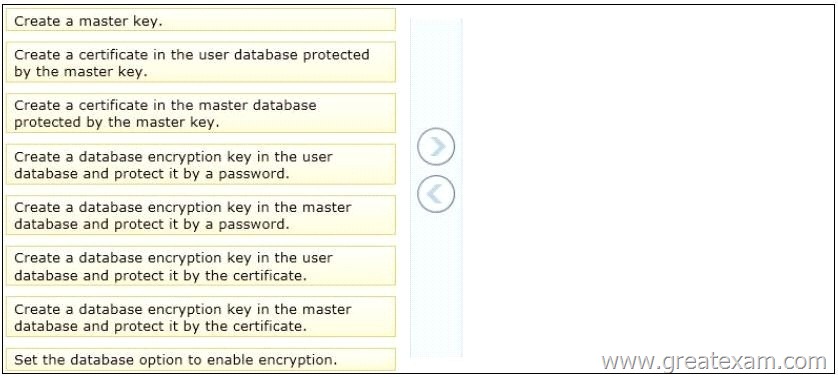
Answer: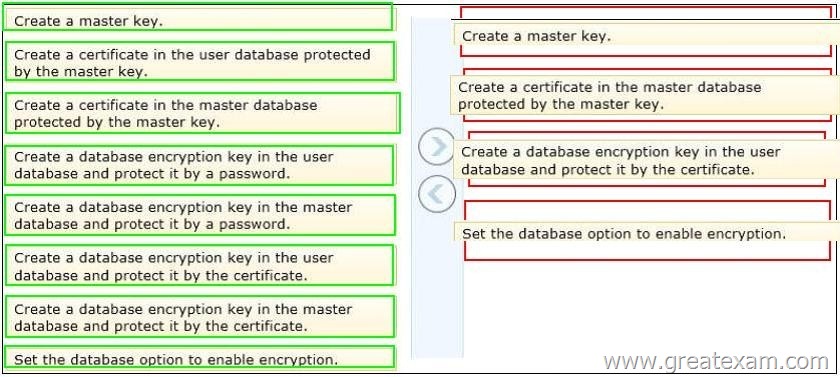
Explanation:
http://msdn.microsoft.com/en-us/library/bb510663.aspx
http://msdn.microsoft.com/en-us/library/bb934049.aspx
QUESTION 95
Drag and Drop Question
You administer a Microsoft SQL Server 2012 database.
The database uses SQL Server Agent jobs to perform regular FULL and LOG backups.
The database uses the FULL recovery model.
You plan to perform a bulk import of a very large text file.
You need to ensure that the following requirements are met during the bulk operation:
– The database transaction log is minimally affected.
– The database is online and all user transactions are recoverable.
– All transactions are fully recoverable prior to the import.
Which three actions should you perform in sequence? (To answer, move the appropriate actions from the list of actions to the answer area and arrange them in the correct order.)
Answer:
Explanation:
http://technet.microsoft.com/en-us/library/ms187048.aspx
http://technet.microsoft.com/en-us/library/ms189272.aspx
QUESTION 96
You administer a Microsoft SQL Server database named Sales.
The database is 3 terabytes in size.
The Sales database is configured as shown in the following table.
You discover that Sales_2.ndf is corrupt.
You need to recover the corrupted data in the minimum amount of time.
What should you do?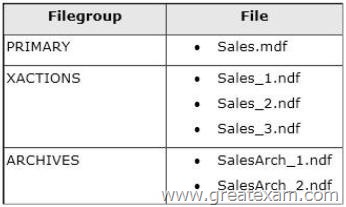
A. Perform a file restore.
B. Perform a transaction log restore.
C. Perform a restore from a full backup.
D. Perform a filegroup restore.
Answer: A
Explanation:
http://technet.microsoft.com/en-us/library/ms187048.aspx
http://msdn.microsoft.com/en-us/library/aa337540.aspx
QUESTION 97
You are developing a SQL Server Integration Services (SSIS) package to load data into a data warehouse.
You need to establish the correct order for loading each table to maximize parallel processing. Which order should you use?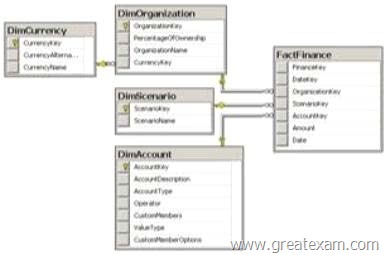
A. 1. DimCurrency, DimScenario, DimAccount in parallel
2. DimOrganization
3. FactFinance
B. 1. DimCurrency, DimOrganization in parallel
2. DimScenario, DimAccount in parallel
3. FactFinance
C. 1. DimCurrency, FactFinance in parallel
2. DimOrganization, DimScenario, DimAccount in parallel
D. 1. FactFinance
2. DimOrganization, DimScenario, DimAccount in parallel
3. DimCurrency
E. 1. DimCurrency
2. DimOrganization
3. DimScenario, DimAccount in parallel
4. FactFinance
Answer: A
Explanation:
http://msdn.microsoft.com/en-us/library/ms139892.aspx
http://msdn.microsoft.com/en-us/library/ms141261.aspx
QUESTION 98
You are migrating a database named Orders to a new server that runs Microsoft SQL Server 2012.
You attempt to add a SQL login, [User1], to the database.
However, you receive the following error message:
“User already exists in current database.”
You need to configure the [User1] login to be able to access the Orders database and retain the original permissions.
You need to achieve this goal by using the minimum required permissions.
Which Transact-SQL statement should you use?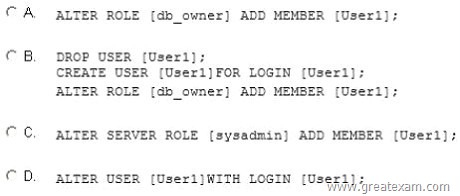
A. Option A
B. Option B
C. Option C
D. Option D
Answer: B
QUESTION 99
Occasionally a job that executes an existing SQL Server Integration Services (SSIS) package does not complete and nothing is processed.
You need to ensure that package logging occurs.
Your solution must minimize deployment and development efforts.
What should you do?
A. Create a reusable custom logging component.
B. Use the gacutil command.
C. Use the Project Deployment Wizard.
D. Run the package by using the dtexec /rep /conn command.
E. Add a data tap on the output of a component in the package data flow.
F. Create an OnError event handler.
G. Use the dtutil /copy command.
H. Deploy the package by using an msi file.
I. Run the package by using the dtexec /dumperror /conn command.
J. Run the package by using the dtexecui.exe utility and the SQL Log provider.
K. Deploy the package to the Integration Services catalog by using dtutil and use SQL Server to store the configuration.
Answer: C
QUESTION 100
Note: This question is part of a series of questions that use the same or similar answer choices. An answer choice may be correct for more than one question in the series.
Each question is independent of the other questions in this series.
Information and details provided in a question apply only to that question.
To facilitate the troubleshooting of SQL Server Integration Services (SSIS) packages, a logging methodology is put in place.
The methodology has the following requirements:
– The deployment process must be simplified.
– All the logs must be centralized in SQL Server.
– Log data must be available via reports or T-SQL.
– Log archival must be automated.
You need to configure a logging methodology that meets the requirements while minimizing the amount of deployment and development effort.
What should you do?
A. Open a command prompt and run the gacutil command.
B. Open a command prompt and execute the package by using the SQL Log provider and running the dtexecui.exe utility.
C. Add an OnError event handler to the SSIS project.
D. Use an msi file to deploy the package on the server.
E. Configure the output of a component in the package data flow to use a data tap.
F. Run the dtutil command to deploy the package to the SSIS catalog and store the configuration in SQL Server.
G. Open a command prompt and run the dtexec /rep /conn command.
H. Open a command prompt and run the dtutil /copy command.
I. Open a command prompt and run the dtexec /dumperror /conn command.
J. Configure the SSIS solution to use the Project Deployment Model.
K. Create a reusable custom logging component and use it in the SSIS project.
Answer: B
Explanation:
http://msdn.microsoft.com/en-us/library/ms140246.aspx
http://msdn.microsoft.com/en-us/library/hh231187.aspx
GreatExam offers the latest Microsoft 70-458 dumps and a good range of Microsoft Certification 70-458 answers. Most of our Microsoft 70-458 exam dumps are exclusively prepared by the best brains and highly skilled professionals from the IT domain to ensure 100% pass in your Microsoft 70-458 Exam.